Middle Eastern Pottery in Italy and Europe
Trade pottery from the Islamic world
Glazed pottery made in the Islamic world made its way far beyone the borders of that world, to the furthest limits of the Old World. One area of particular interest that recieved pottery from the Middle East is Italy. The brightly coloured and decorated glazed wares were in particular used to decorate churches, and were even broken down and sued as tesserae, the small tiles used in mosaics! Study of these wares works for both the study of pottery from the Islamic world, and for the study of the monuments and of the archaeology of Italy, as it provides dating evidence that can go either way, and provides contextualisation of trade and other contacts across the Mediterranean in the Medieval period.

Ravello, Duomo: this cathedral church, founded in 1086 AD, contains an ambo, a type of lecturn, of about 1130AD. The margins of the structure are decorated with mosaics, and there are also depictions of Jonah being swallowed by a whale which are also mosaics. Close inspection of the tesserae reveals that they are in fact fragments of glazed pottery.
The fragments with brownish-greenish paint on are lustre-wares. They have glazes which are white and made opaque by the prsence of tin-oxides; the lustre-pigments tend to be various hues; and the paint has often been scratched through with fine lines. Even though these fragments are no bigger than a centimeter in diameter, it is possible, given my comprhensive study of lustre-wares, to be certain that these atrributes indicate that they were made in Fustat, or Old Cairo, in Egypt, and date to around 1025-1075 AD.
The other tesserae have coloured glazes. Most of those visible in the image are green, while some are turquoise, and blue. Some of the green-glazed fragments have opaque glazes, and it is actually possible to discern lustre-paint on them, and so the green-opaque glazed fragments are lustre-wares. Lustre wares with opaque green glazes are also distinctive of production in Fustat around 1025-1075 AD.
The other green glazes are transparent, and it can be seen that the body inder the glaze has been incised to create a decoration. These Incised wares are a well-known ceramic type from the Islamic world (examples can be seen from Tell al-Acharneh, in Syria, on the web-page on Syrian projects). It might be noted that the Tell al-Acharneh examples, which are of the "Tell Minis" style do not include any green-glazed wares, only turquoise, blue, and colourless examples. Green-glazed Incised wares were actually only made in Fustat, between circa 1025 and 1125 AD. The turquoise and blue examples on the Ravello duomo ambo are most likely also of the same date.
So all of the fragments of pottery on the ambo of the Ravello duomo were most likely made in Fustat, Egypt, between circa 1025 and 1125 AD, with the lustre-wares and possibly all of the Incised wares actually made in the first half of that time range.
Ravello, San Giovanni del Toro: This 12th century AD church also contains a lecturn, again with a mosaic whcih is comprised of fragments of pottery from the Islamic world, and also larger pieces from the interiors of bowls. The tesserae are of pottery with the quartzose stonpast body, and a transparent turquoise glaze. Very rarely can be seen evidence of black paint to indicate that these are actually fragments of under-glaze painted wares. The black lines are found in an arcuate patter typical of production in Syria in the 2nd half of the 12th century AD, particularly from production at centres like Damascus.
Most of the larger pieces set into the lecturn are also typical of late 12th and early 13th century production in Syria, most likely at Damascus. A couple of the fragments, however, are lustre wares, for example of the two illustrated, the one on the right is a lsuter-ware. These fragments have glazes coloured blue by cobalt, and the lustre-paint has been scratched-through to create a decorative effect. Unlike the fragments of lustre-wares with scratched paint found in the lecturn at the Ravello Duomo, these have a transparent glaze, not a tin-opacified glaze. hence these are the earliest Syrian lustre wares, often called "Tell Minis" wares, and were made, probably in Western Syria, betwen circa 1075 and 1125 AD.
So unlike the mosaic at the Ravello duomo, which might represent a few years of production, it seems that the pottery fragments ine the lecturn at San Giovanni del Toro in Ravello represents as much as 200 years of production in Syria.
Amalfi, duomo of San Andreas: Some fragments of Middle Eastern pottery are also preserved in this impressive church, although none seem to be in their original placement. In the cloister are exhbited some fragments of marble structures similar to the lecturns at the Ravello churches. These have the quartzose stonepaste body, black underglaze paint, and a transparent turquoise glaze like the fragments from San Giovanni in Ravello. They are also probably from Damascus and of late 12th century date.
Inside the church are some far more recent lecturns, each side of the altar. Although they are of a baroque style, they are actually re-used pieces from medieval structures, made of marble with mosaic decoration, very like the decoration on the ambo in the Ravello duomo. These also include fragments of Middle Eastern ceramics, which have pale tin-opacified glazes, and seem to most closely resemble some of the early 12th century fragments that originate in Fusta, Egypt.
Salerno: The local archaeologist concerned with the medieval period, Prof. Peduto of the University of Salerno also showed me some fragments from excavations in the area, including the illustrated albarello type jar, probably made in Damascus, and of early 13th century date.
Rome, Ss. Giovanni e Paolo: The campanile or bell-tower of this church has examples of what are often called bacini in Italy: ceramic vessels set into the architecture as a decorative element.

In the case of the bacini from Ss. Giovanni e Paolo they have all been removed and are very nicely displayed in the rather spiffy museum under the church. They all seem to be early Spanish lustre-wares, and possibly not from the Middle East at all, but it would be worth arranging a proper visit to examine the vessels in closer detail.
Rome, San Francesca Roma: This church in the Forum also examples of bacini in its campanile. Unfortunately the museum was shut! But it would certainly be worth another visit, and perhaps contacting the local archaeologists beforehand next time!
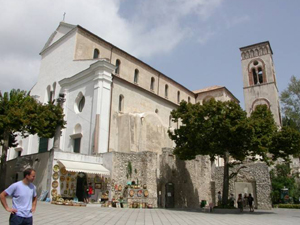
Ravello Duomo
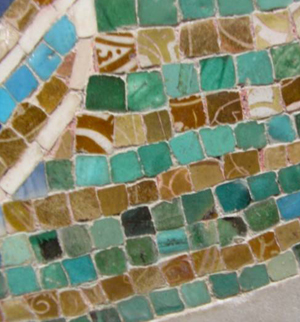
Mosaic on lectern in Ravello
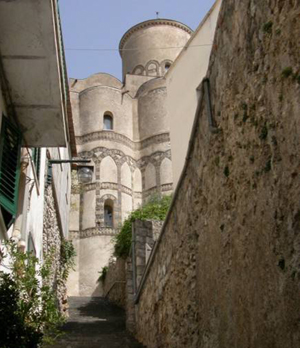
San Giovanni del Toro, Ravello
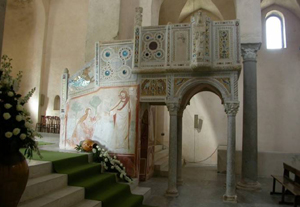
Lecturn, San Giovanni del Toro, Ravello
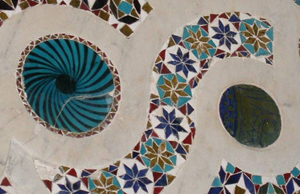
Ceramics in lecturn, San Giovanni del Toro, Ravello
Fragment of structure exhibited in the cloister of the duomo of San Andreas, Amalfi, with fragments of late 12th century Damascus pottery
Syrian jar excavated in the Salerno area.
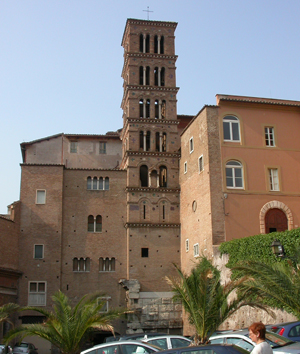
The campanile of Ss. Giovanni e Paolo, Rome
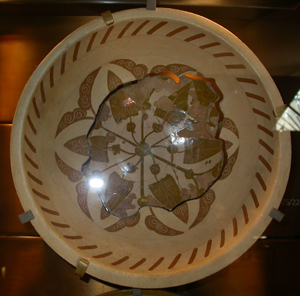
Bacini from the campanile of Ss. Giovanni e Paolo, Rome
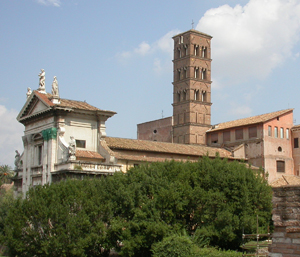
San Francesca Romana
|